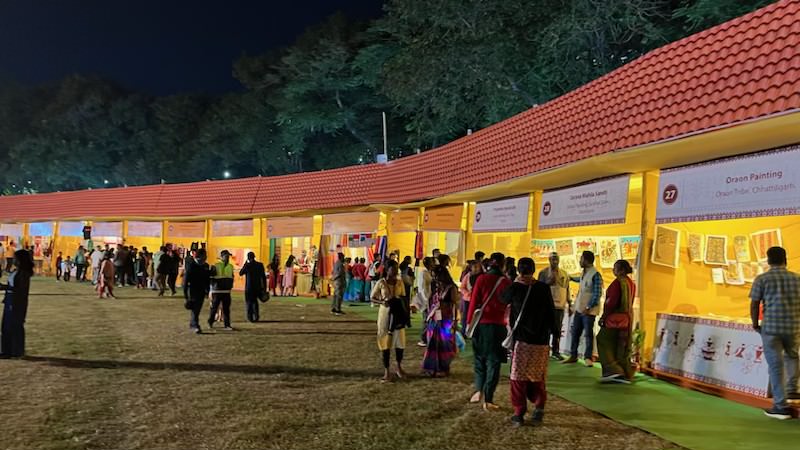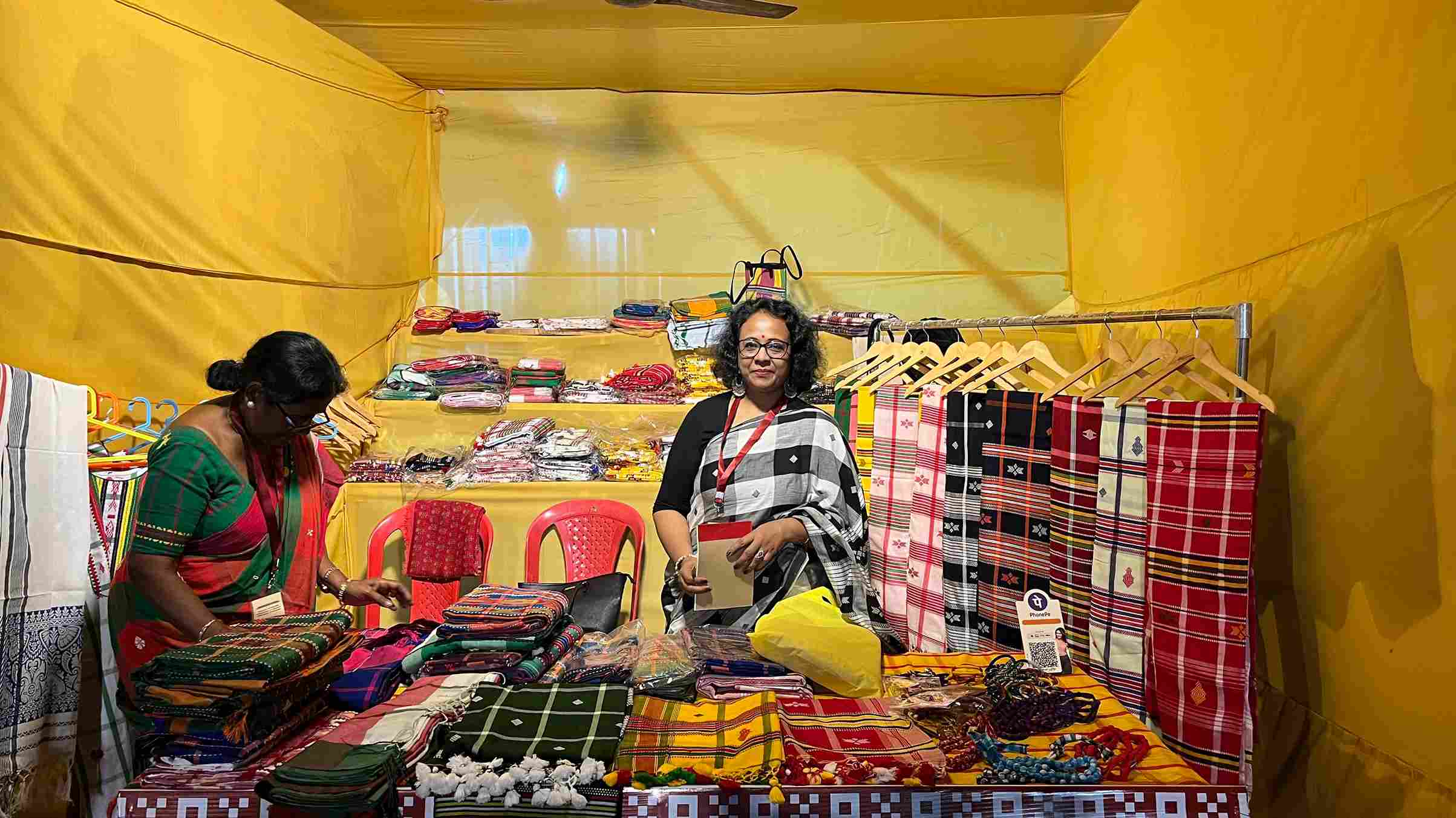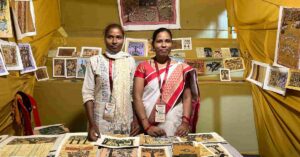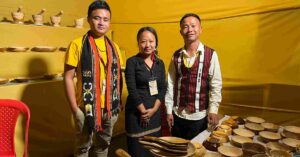110 Tribal Artisans Showcased Lost Art Forms India Needs to Preserve
At the Tata Samvaad conclave in Jamshedpur, artisans from indigenous tribes across India shone a spotlight on fading tribal arts, reviving them with contemporary flair to build livelihoods.

This article has been published in partnership with Samvaad – Enabled by Tata Steel Foundation.
In 2019, Brijesh Bhusara from Dadra Nagar Haveli walked the ramp at Samvaad. Back then, it was unusual for someone from the Kokna tribe to be invited to a fashion show. Now, nearly four years later, Brijesh, an active participant in Samvaad — Enabled by Tata Steel Foundation (TSF) — is celebrated not only by his tribe but also by neighbouring tribes like Konkani, Warli, and Dhodia.
During the five-day Samvaad conclave at Jamshedpur’s Gopal Maidan, Brijesh and 109 other artisans displayed their cultural heritage through various creations.
Brijesh showcased traditional woodcrafts and Warli art, giving a contemporary twist to a 400-year-old culture. His products — including umbrellas, fridge magnets, shawls, saris, and T-shirts — feature traditional triangular figurines but use modern colour and font combinations. This fusion was evident in most stalls at the event, which transformed Gopal Maidan into a vibrant ceremonial ground with hand-printed silks, textiles, woven fabrics, mud paintings, bamboo items, and traditional clothing from 15 to 19 November 2023.

What is Samvaad?
Samvaad, enabled by Tata Steel Foundation is among the country’s biggest tribal gatherings, bringing together over 2,500 people from 200 tribes.
Samvaad, which stepped into its tenth year, has created a stable and consistent ecosystem for dialogue on tribal discourse. Tribes from across India come together to address issues affecting their communities and look for solutions.
In the last decade, Samvaad has brought together over 40,000 people from over 200 tribes in India and 17 other countries.
The 10th edition commenced with the traditional beats of 251 nagadas, dhols, and musical instruments, commemorating the birth anniversary of Birsa Munda, the iconic tribal freedom fighter from Jharkhand.
The theme for this edition was ‘Walk with Me’, reflecting on the journey of ideas, collectives, and changemakers associated with Samvaad since its inception. It acknowledged the impact of solution-driven dialogues and conversations from the past decade.
“Over the last 10 years, the tribal art and craft have been on the verge of extinction due to several reasons like lack of remuneration, migration, or the next generation does not want to do it. We have been working on reviving the art by solving these problems. Art is directly related to one’s identity and culture,” Smita Verma, Lead – Gender & Community Enterprise, TSF, tells The Better India.

‘We are proud of our identity’
Led by Brijesh, the Sankalp Foundation involves around 300 people from 72 villages. This collective provides a platform for artists to learn about current trends and marketing strategies.
“It is a beautiful chaos when multiple tribal communities come together to make the products. Although the communities have different traditions, their turmoil is mostly similar, which then becomes a point of unity. People that were once ashamed of their skills and identities are now proudly wearing and adorning them while making money,” says Brijesh.
Being close to nature, the Sankalp Foundation is happy to walk on the sustainability route. All their wooden products are made from fallen chikoo twigs and branches.
Sustainability is also a winner in Brijesh’s neighbouring handloom stall belonging to the Bodo tribes of Assam. “All our cotton clothes are made from natural colours that last forever and are also good for the skin. We make colours from turmeric, leaves from plants and a few vegetables,” says Jaison Bhramo.
Jyotisankar Sahu of the Sabar tribe from Odisha is here for the second time. For him, the best benefit of putting up a stall is making his digital debut. “We are a group of 70 people who make brass showpieces. We always get orders after we return home from the conclave. Samvaad is a good platform to preserve our culture and tell the world about the exceptional skills that we learnt from our ancestors,” he says.
Besides the exposure, the artisans are also happy to see people taking an interest in their traditions. Sangeeta Meda from the Bhil tribe of Madhya Pradesh says, “This is our second time here, and people always ask us about our history and the significance of our Bhil Pithora paintings.”
“Our ancestors would make these dotted paintings on walls during festivities. Gradually, they moved onto paper. Our paintings tell the stories of our origin and who we are. While selling, we let the customers know our intention behind choosing a particular colour and theme. They feel connected to us. My grandmother, Buri Bai, was awarded Padma Shri for her preservation efforts. We are here to carry forward her legacy,” she adds.
Sangeeta shares that the family starts the work nearly eight months before Samvaad as it takes 10 days to make one painting. She happily adds that their paintings sell like hotcakes!

A few stalls away is Dinabandhu Soren from Odisha’s Ho tribe. It is his ninth year at Samvaad, and each year has been fruitful for him.
“Selling our paintings was a loss-making business in Ganjam district till we learnt about Samvaad. The workshops helped create a balance between our traditional painting techniques and the market demands. With a few tweaks and the right market linkages, we sold gond, sohra and juang paintings at Samvaad and across India. We were even selected to do live sketching at G20 this year,” says Soren.
He is also an art teacher at Srujanika, a women-led self-help group. Srujanika has 30 women who make paintings, Army uniforms, and other merchandise like dupattas and T-shirts throughout the year. Thanks to the profits, the women are passing on the skills to their children now.
Yazile from Nagaland’s Rengma tribe has a similar journey, from no sales to selling pan India. “Nearly every homemaker in the Dimapur area can make our traditional attire, mekhelas and shawls. The skills were there, but the selling opportunity was missing. We attended a workshop at Samvaad and learned that new designs can be implemented on pillow covers, cushion covers, T-shirts, etc. In our second year, we did that and made profits. I also made friends from other tribal communities to learn more about fashion trends across India,” says Yazile.
The art and craft workshops helped artists like Yazile and Dinabandhu post-pandemic when the market crashed and selling at local haats became impossible.
“We started building online market links for 26 tribal communities representing 30 art forms. We wanted to make Toda embroidery of Nilgiris, Muga silk of Assam, and more as popular as Banarasi, Ikat and Chikankari. We brought in experts from NIFT and NID to impart the skills, colour combinations, motifs, etc, that meet customer demands,” says Smita.
She adds, “Trends in the metro change fast, so we ask them not to change their cultural identity. But they can experiment with colours and motifs. For example, if pastel colour is in the market, infuse those colours in the products,” she adds.
The thronging crowds at handicraft stalls were proof that the workshops were beneficial. Chaaya Saraiwala, an attendee, purchased Yazile’s shawls and Brijesh’s fridge magnets. If you found our stories insightful, informative, or even just enjoyable, we invite you to consider making a voluntary payment to support the work we do at The Better India. Your contribution helps us continue producing quality content that educates, inspires, and drives positive change. Choose one of the payment options below for your contribution- By paying for the stories you value, you directly contribute to sustaining our efforts focused on making a difference in the world. Together, let’s ensure that impactful stories continue to be told and shared, enriching lives and communities alike. Thank you for your support. Here are some frequently asked questions you might find helpful to know why you are contributing?

“This is my first time attending Samvaad and I am so happy to see the myriad products from different parts of our country. I have bought a few items for my family. Each product has a story to tell. There is so much history that we do not know, but I am glad that conclaves like Samvaad are changing that,” she shares.
(Edited by Pranita Bhat; All photos courtesy: Samvaad by Tata Steel Foundation)
This story made me
-
97
-
121
-
89
-
167













